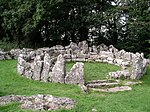Moelfre Lifeboat Station

Moelfre Lifeboat Station is located in the village of Moelfre, Anglesey and is run by the Royal National Lifeboat Institution. The present boathouse became operational in March 2015.The original boathouse was built in 1875 closer to the centre of the village and was replaced in 1909 by one occupying the present location. This was modified several times between 1930 and 1993 to accommodate larger boats; its slipway had been commensurately lengthened as well. This station was stone-built with rendered walls and a slate roof, on a rectangular base of coursed, squared limestone.There are 2 lifeboats present at the station. The All Weather boat, Tamar class, reference (16-25) is called "Kiwi" in appreciation of the major sponsor of the boat's construction who happened to hail from New Zealand. The inshore boat is a D class RIB called Enfys. The all weather normally has a crew of 6 or 7 and the inshore 3.
Excerpt from the Wikipedia article Moelfre Lifeboat Station (License: CC BY-SA 3.0, Authors, Images).Moelfre Lifeboat Station
Cil Swnt,
Geographical coordinates (GPS) Address Website External links Nearby Places Show on map
Geographical coordinates (GPS)
| Latitude | Longitude |
|---|---|
| N 53.35467 ° | E -4.23195 ° |
Address
Moelfre Lifeboat Station
Cil Swnt
LL72 8HU , Moelfre
Wales, United Kingdom
Open on Google Maps










